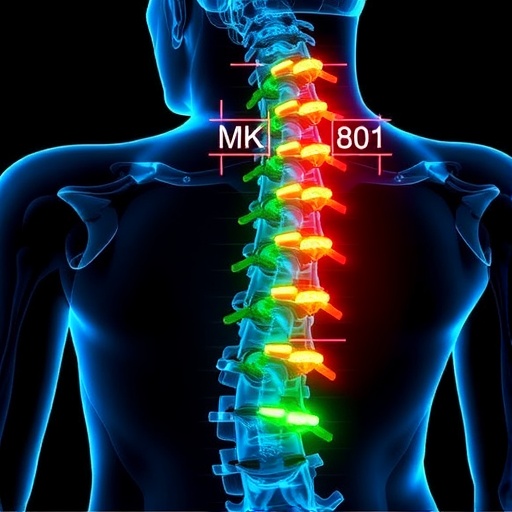In a world increasingly focused on finding effective treatments for neurotrauma, recent developments surrounding MK801 have drawn considerable interest within the scientific community. The article in question, titled “Retraction Note: MK801 attenuates secondary injury in a mouse experimental compression model of spinal cord trauma,” raises essential discussions about the potential implications of this compound in therapeutic contexts. Esteemed researchers Esposito, Paterniti, and Mazzon, alongside their colleagues, delve into the complexities of spinal cord injuries (SCIs) and address vital concerns regarding therapeutic efficacy and safety.
As the prevalence of spinal cord injuries continues to rise, particularly among populations such as athletes and accident victims, the urgency to discover viable treatment options cannot be overstated. The search for pharmacological interventions that mitigate secondary injury processes—those occurring in the hours and days following the initial trauma—has become paramount. Injury to the spinal cord triggers a cascade of cellular and molecular events that can exacerbate damage, making the exploration of compounds like MK801 a topic of crucial relevance.
At the core of this research is MK801, an NMDA receptor antagonist that has garnered attention for its neuroprotective properties. By blocking the excitotoxic effects mediated by excessive glutamate—a common consequence of neuronal injury—MK801 offers a potential strategy for reducing secondary injury. Studies have shown that excitotoxicity not only contributes to cell death but also amplifies the inflammatory response, further complicating recovery. This makes the role of MK801 an exciting focal point in the realm of spinal cord injury research.
What makes the findings attributed to MK801 even more significant is their grounding in a well-structured experimental framework. Utilizing mouse models, the researchers conducted compression injury trials that closely mimic the physiological environments of human cases. This level of contextual relevance ensures that the observed therapeutic potential of MK801 is not merely theoretical but holds practical relevance for clinical interventions. The methodology highlights a growing trend in neuroscience research: the use of animal models to achieve insights into human health challenges.
However, with great interest comes the paramount responsibility of verifying and validating scientific claims. The retraction note issued by the researchers indicates that, despite promising initial findings, uncertainties remained regarding the reproducibility of the results. The scientific community places immense value on reproducibility, as it serves as a cornerstone of reliable research. Hence, the decision to retract the article reflects a commitment to maintaining scientific integrity.
In exploring the implications of the retraction note, it is essential to consider the broader context in which this research exists. Spinal cord injuries not only present physical challenges but also have profound emotional and psychological ramifications. Patients often face life-altering consequences, including paralysis and loss of function, underscoring the need for effective therapeutic interventions that extend beyond mere symptom management. Studies exploring neuroprotective agents like MK801 are critical in developing a comprehensive understanding of how to support recovery and improve the quality of life for those affected.
Furthermore, discussions around MK801 should not be limited to its neuroprotective capabilities. Research into the pharmacokinetics and pharmacodynamics of the compound is necessary to understand its bioavailability and systemic effects when administered in vivo. As a compound with potential applications in treating acute neurotrauma, insights into how MK801 interacts with various neural pathways can lead to optimized treatment protocols, particularly in the critical hours following spinal cord injury.
The implications of behavioral and cognitive outcomes in the wake of spinal injuries bring forth additional depths to the discourse around MK801. Neuroprotective interventions can achieve more than just minimizing physical damage; they have the potential to mitigate the long-lasting cognitive and emotional disturbances that often accompany spinal cord trauma. A comprehensive investigation into how agents like MK801 affect recovery trajectories could pave the way for new standards in therapeutic care.
In light of the recent retraction, it is imperative for the scientific community to dissect how such incidents can be mitigated in the future. Rigorous peer review processes, enhanced transparency in methodologies, and thorough statistical analyses can bolster the reliability of findings, thus fostering trust in the published literature. These measures not only protect scientific integrity but also fortify public and institutional trust in research outputs.
Ultimately, while the retraction raises questions about the current findings linked to MK801, it does not overshadow the importance of continued exploration in the realm of spinal cord injury treatments. The pursuit of effective therapies must persist, driven by a desire to improve recovery rates and overall outcomes. Researchers are encouraged to build on past inquiries, refining hypotheses and employing innovative methodologies to ascertain the true potential of compounds like MK801.
In conclusion, MK801 presents an intriguing narrative within the domain of spinal cord injury research, embodying both promise and caution. The road to developing effective therapeutic strategies is filled with challenges, yet the commitment to scientific rigor and improvement remains unwavering. As the community reflects on the implications of the recent retraction, renewed focus on transparency and reproducibility will undoubtedly lead to more robust research outcomes in the future. The dialogue surrounding MK801 and its role in neuroprotection will continue, underscoring the evolving nature of scientific discovery.
Subject of Research: Neuroprotective effects of MK801 in spinal cord injury
Article Title: Retraction Note: MK801 attenuates secondary injury in a mouse experimental compression model of spinal cord trauma
Article References:
Esposito, E., Paterniti, I., Mazzon, E. et al. Retraction Note: MK801 attenuates secondary injury in a mouse experimental compression model of spinal cord trauma.
BMC Neurosci 26, 28 (2025). https://doi.org/10.1186/s12868-025-00949-5
Image Credits: AI Generated
DOI:
Keywords: MK801, spinal cord injury, neuroprotection, retraction, research integrity
Tags: advancements in spinal cord injury researchathlete spinal cord injury prevalencecellular events following spinal cord injuryexperimental compression model of spinal cord traumaglutamate excitotoxicity reductionMK801 neuroprotective propertiesneurotrauma treatment developmentsNMDA receptor antagonistspharmacological interventions for neurotraumasecondary injury mitigationspinal cord injury treatment optionstherapeutic efficacy in spinal cord injuries





